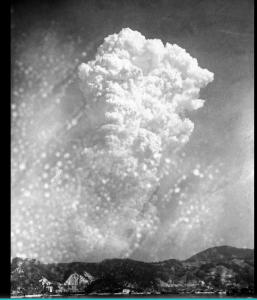DOCUMENT – This US-Air Force photo-smoke column on August 6, 1945, rises 20,000 feet above Hiroshima, western Japan, after the first 5-tonne “Little Boy” atomic bomb was dropped. Hiroshima was targeted because it was an important military center in Japan, full of military bases and ammunition structures. The city of Hiroshima on Thursday, August 6, 2020 marks the 75th anniversary of the world’s first nuclear attack.

FILM 17 – On August 6, 1945, a file released by the U.S.
Air Force, a column of smoke rises 20,000 feet above Hiroshima, western Japan, after the first 5-tonne “Little Boy” atomic bomb was dropped. Hiroshima was targeted because it was an important military center in Japan, full of military bases and ammunition structures. Hiroshima city in the photo: George R. Caron, AP
DOCUMENT – In this archive photo, released on August 6, 1945, by the American Air Force, white smoke rises from the detonation of an atomic bomb in Hiroshima, western Japan. At 8.15am, U.S. B-29 bomber Enola Gay dropped a 4-ton uranium bomb “Little Boy” from the city center from a height of 9,600 meters (31,500 feet), aiming at Aioi Bridge. The bomb exploded 43 seconds later, 600 meters (2000 feet) above the ground
17 DOCUMENT – This photo, taken on August 6, 1945, by the US Air Force, raises white smoke from an atomic bomb detonation to Hiroshima, western Japan. At 8.15am, U.S. Bomber B-29 Enola Gay dropped a 4-ton uranium “Little Boy” bomb from a city center from a height of 9,600 meters (31,500 feet), aiming at Aioi Bridge
The city of Hiroshima in western Japan celebrates the 75th anniversary of the world’s first nuclear attack on Thursday.
Three days after the bombing of Hiroshima on August 6, 1945, the United States launched the second atomic bomb in Nagasaki. Japan surrendered on August 15, at the end of World War II and, in general, almost half a century of aggression against its Asian neighbors.
Q. Why was Hiroshima chosen as the target?
A. Hiroshima was an important Japanese military hub with factories, military bases and ammunition facilities. Historians say the United States chose it as an appropriate target because of its size and landscape, and carefully avoided pre-bombing the city so that American officials could accurately assess the impact of the atomic attack. . The United States claimed that the bombing accelerated Japan’s surrender and prevented a US invasion of Japan. Some historians say today that Japan was already close to surrendering, but there is still debate in the United States. 5 decks to try at Hearthstone’s Scholomance Academy on the first day
Q. What happened in the attack?
A. At 8.15 a.m., U.S. Bomber B-29 Enola Gay dropped a 4-ton uranium “Little Boy” bomb from the city center from a target bridge aimed at the bridge. Aioi. The bomb exploded 43 seconds later, 600 meters (2000 feet) above the ground. The calculated temperature one second after detonation was 3000-4000 degrees Celsius (5400-7200 degrees Fahrenheit) at zero. The explosion and heat rays destroyed almost the entire 2 kilometers (1.2 miles) from scratch. Within an hour, a “black rain” of highly radioactive particles began to pour into the city, causing further radiation exposure.
Q. How many people have been killed?
A. About 140,000 people, including those with radiation-related injuries and illnesses, died by 31 December 1945. That was 40% of Hiroshima’s 350,000 population before the attack. That day, everyone died 500 meters (1,600 feet) from scratch. To date, the total number of deaths, including those from radiation-related cancer, is about 300,000. Hiroshima has a population of 1.2 million today.
Q. What was the effect of radiation?
A. Many people exposed to radiation have developed symptoms such as vomiting and hair loss. Most people with severe radiation symptoms died within 3 to 6 weeks. Others who have lived further have developed health problems associated with burns, radiation-induced tumors and other diseases. Survivors are at higher risk of developing cataracts and cancer. Some 136,700 people certified as “hibakusha”, as the victims are called, are still alive under the government’s support program and are entitled to regular health check-ups and free treatment. Ibacus health monitoring
Leave a Reply